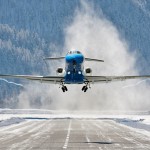Ask The Pilot: Can it be too cold for an aircraft to fly?
As temperatures in Siberia hit an unusual low of -52C earlier this month, the brake system on a Katekavia airlines Tupolev 134 froze solid in the parked position. This made it impossible for the aircraft to taxi to the runway and passengers due to take a flight from the remote Igarka airport got out and pushed the aircraft onto the runway.

Once on the runway, the aircraft took off as normal and landed safely later, in the planned destination of Krasnoyarsk.
This is a good example of how aircraft can operate in extreme cold once they are in the air. The outside air temperature on a flight at 30,000 feet regularly reach temperatures as low as -80C, or even -100C without any problems.
Aircraft are designed to cope with all weather extremes and the speed and movement keeps the temperature in the engines and fuel tank much higher than the outside temperature. And of course the inside cabin temperature would be much higher still! On a private jet, the temperature is set to your personal preference.

So once in the air, it can’t really be too cold for an aircraft to fly. But it’s on the ground, before take-off that these kinds of extreme temperatures can sometimes cause problems.
Starting the engines can be difficult in unusually cold temperatures such as below -50C. But the maintenance crew are well-briefed on how to warm up the aircraft, if necessary. In extreme cases, heaters can be applied to the engines to warm them up before starting, particularly for turboprop engines.
Another on-the-ground problem is frozen aircraft parts – such as the brake pads on the Siberian flight or aircraft seals. However modern enginneering technology means that aircraft are built to make this a rare problem. The -52C in Siberia was an unusual low, even for this very cold part of the world.
De-icing the aircraft and the runway is a more common consideration – at any sub-zero temperatures. Both the aircraft and the runway need to be clear of ice and snow. Airports in cold climates usually have the equipment to cope with this. But of course people are needed outside in the cold to operate it! Usually maintenance crews will be equipped with cold weather clothing and exposure isn’t a problem for anything up to -20C or so. But in very extreme temperatures, they work in short spells of 20 minutes, before going inside.
De-icing can add extra costs to a private jet flight. Here’s our guide to de-icing and how to minimise the costs.
For advice and pricing on winter flights, contact us or speak to our Flight Team (24 hours) on +44 1747 642 777
Related content

What happens after you book a flight with PrivateFly?

Can a private jet fly in the snow?



